Economic 545: Macroeconomic Challenges of Inflation & Unemployment
VerifiedAdded on 2022/10/01
|13
|2476
|22
Report
AI Summary
This report provides a comprehensive analysis of macroeconomic challenges, specifically focusing on unemployment and inflation. It begins with an introduction and data section, exploring unemployment rates, inflation trends, and relevant economic indicators like GDP. The report examines the impact of these factors on various demographics, including education levels and gender. Part II delves into a detailed analysis of the data, discussing the relationship between unemployment, inflation, and economic growth. It considers the business cycle and its effects on unemployment and inflation, with a reflection on the four phases of the business cycle. The report then proposes monetary and fiscal policy solutions to address the challenges of unemployment and inflation, including the creation of new job opportunities and cost-effective solutions. The report also discusses the risks associated with fiscal policy, such as increased budget deficits. Finally, the report includes references to support the analysis.
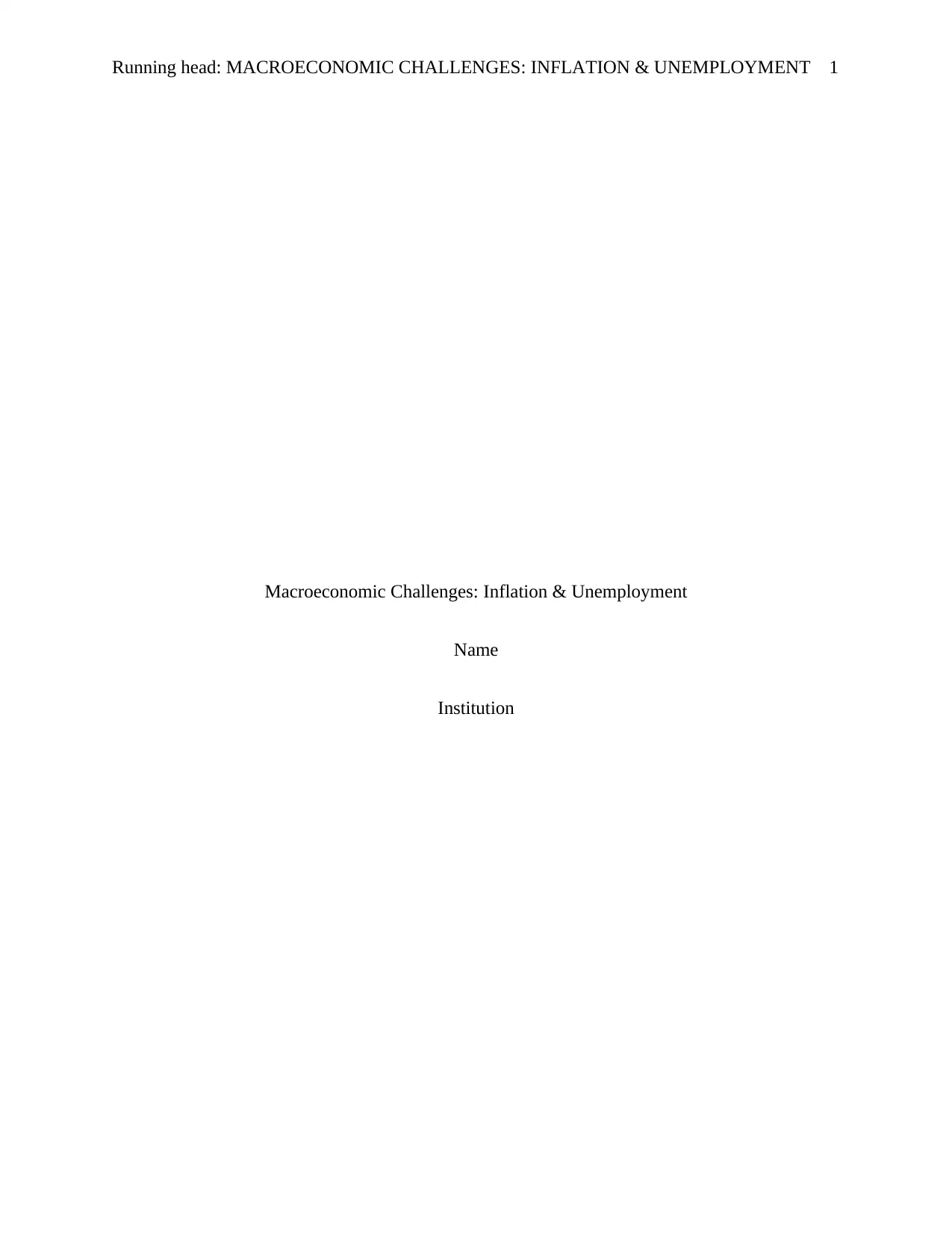
Running head: MACROECONOMIC CHALLENGES: INFLATION & UNEMPLOYMENT 1
Macroeconomic Challenges: Inflation & Unemployment
Name
Institution
Macroeconomic Challenges: Inflation & Unemployment
Name
Institution
Paraphrase This Document
Need a fresh take? Get an instant paraphrase of this document with our AI Paraphraser
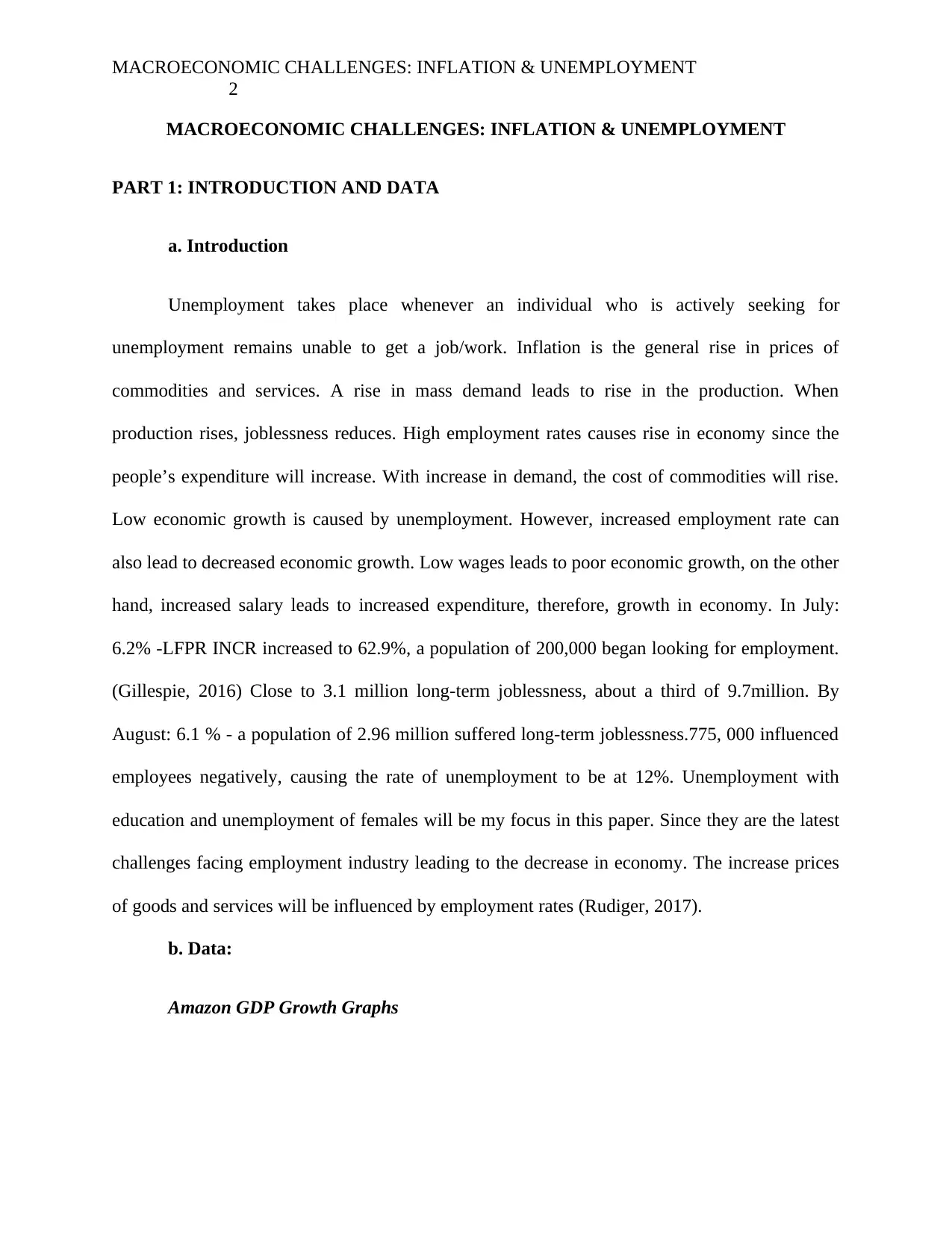
MACROECONOMIC CHALLENGES: INFLATION & UNEMPLOYMENT
2
MACROECONOMIC CHALLENGES: INFLATION & UNEMPLOYMENT
PART 1: INTRODUCTION AND DATA
a. Introduction
Unemployment takes place whenever an individual who is actively seeking for
unemployment remains unable to get a job/work. Inflation is the general rise in prices of
commodities and services. A rise in mass demand leads to rise in the production. When
production rises, joblessness reduces. High employment rates causes rise in economy since the
people’s expenditure will increase. With increase in demand, the cost of commodities will rise.
Low economic growth is caused by unemployment. However, increased employment rate can
also lead to decreased economic growth. Low wages leads to poor economic growth, on the other
hand, increased salary leads to increased expenditure, therefore, growth in economy. In July:
6.2% -LFPR INCR increased to 62.9%, a population of 200,000 began looking for employment.
(Gillespie, 2016) Close to 3.1 million long-term joblessness, about a third of 9.7million. By
August: 6.1 % - a population of 2.96 million suffered long-term joblessness.775, 000 influenced
employees negatively, causing the rate of unemployment to be at 12%. Unemployment with
education and unemployment of females will be my focus in this paper. Since they are the latest
challenges facing employment industry leading to the decrease in economy. The increase prices
of goods and services will be influenced by employment rates (Rudiger, 2017).
b. Data:
Amazon GDP Growth Graphs
2
MACROECONOMIC CHALLENGES: INFLATION & UNEMPLOYMENT
PART 1: INTRODUCTION AND DATA
a. Introduction
Unemployment takes place whenever an individual who is actively seeking for
unemployment remains unable to get a job/work. Inflation is the general rise in prices of
commodities and services. A rise in mass demand leads to rise in the production. When
production rises, joblessness reduces. High employment rates causes rise in economy since the
people’s expenditure will increase. With increase in demand, the cost of commodities will rise.
Low economic growth is caused by unemployment. However, increased employment rate can
also lead to decreased economic growth. Low wages leads to poor economic growth, on the other
hand, increased salary leads to increased expenditure, therefore, growth in economy. In July:
6.2% -LFPR INCR increased to 62.9%, a population of 200,000 began looking for employment.
(Gillespie, 2016) Close to 3.1 million long-term joblessness, about a third of 9.7million. By
August: 6.1 % - a population of 2.96 million suffered long-term joblessness.775, 000 influenced
employees negatively, causing the rate of unemployment to be at 12%. Unemployment with
education and unemployment of females will be my focus in this paper. Since they are the latest
challenges facing employment industry leading to the decrease in economy. The increase prices
of goods and services will be influenced by employment rates (Rudiger, 2017).
b. Data:
Amazon GDP Growth Graphs
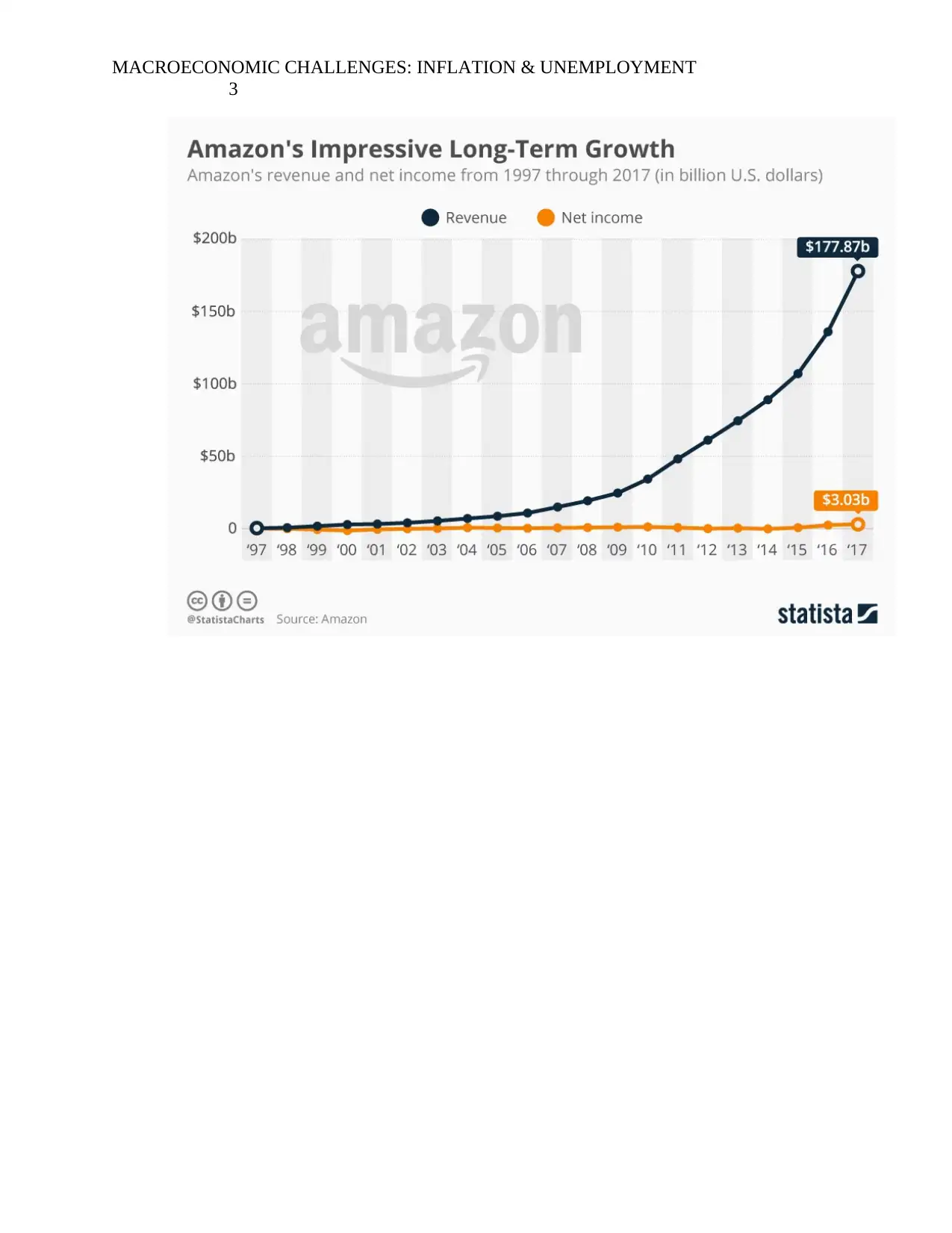
MACROECONOMIC CHALLENGES: INFLATION & UNEMPLOYMENT
3
3
⊘ This is a preview!⊘
Do you want full access?
Subscribe today to unlock all pages.

Trusted by 1+ million students worldwide
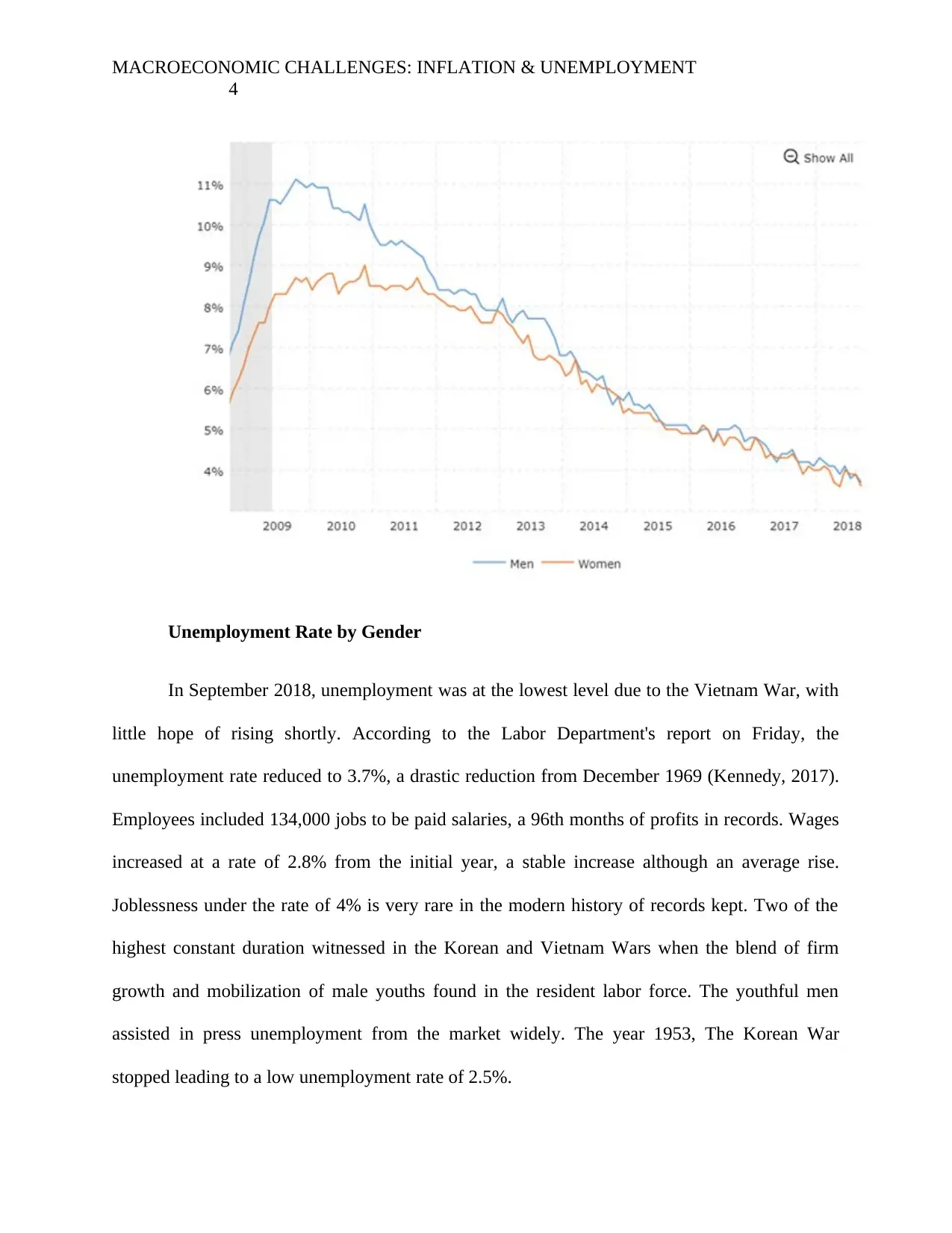
MACROECONOMIC CHALLENGES: INFLATION & UNEMPLOYMENT
4
Unemployment Rate by Gender
In September 2018, unemployment was at the lowest level due to the Vietnam War, with
little hope of rising shortly. According to the Labor Department's report on Friday, the
unemployment rate reduced to 3.7%, a drastic reduction from December 1969 (Kennedy, 2017).
Employees included 134,000 jobs to be paid salaries, a 96th months of profits in records. Wages
increased at a rate of 2.8% from the initial year, a stable increase although an average rise.
Joblessness under the rate of 4% is very rare in the modern history of records kept. Two of the
highest constant duration witnessed in the Korean and Vietnam Wars when the blend of firm
growth and mobilization of male youths found in the resident labor force. The youthful men
assisted in press unemployment from the market widely. The year 1953, The Korean War
stopped leading to a low unemployment rate of 2.5%.
4
Unemployment Rate by Gender
In September 2018, unemployment was at the lowest level due to the Vietnam War, with
little hope of rising shortly. According to the Labor Department's report on Friday, the
unemployment rate reduced to 3.7%, a drastic reduction from December 1969 (Kennedy, 2017).
Employees included 134,000 jobs to be paid salaries, a 96th months of profits in records. Wages
increased at a rate of 2.8% from the initial year, a stable increase although an average rise.
Joblessness under the rate of 4% is very rare in the modern history of records kept. Two of the
highest constant duration witnessed in the Korean and Vietnam Wars when the blend of firm
growth and mobilization of male youths found in the resident labor force. The youthful men
assisted in press unemployment from the market widely. The year 1953, The Korean War
stopped leading to a low unemployment rate of 2.5%.
Paraphrase This Document
Need a fresh take? Get an instant paraphrase of this document with our AI Paraphraser
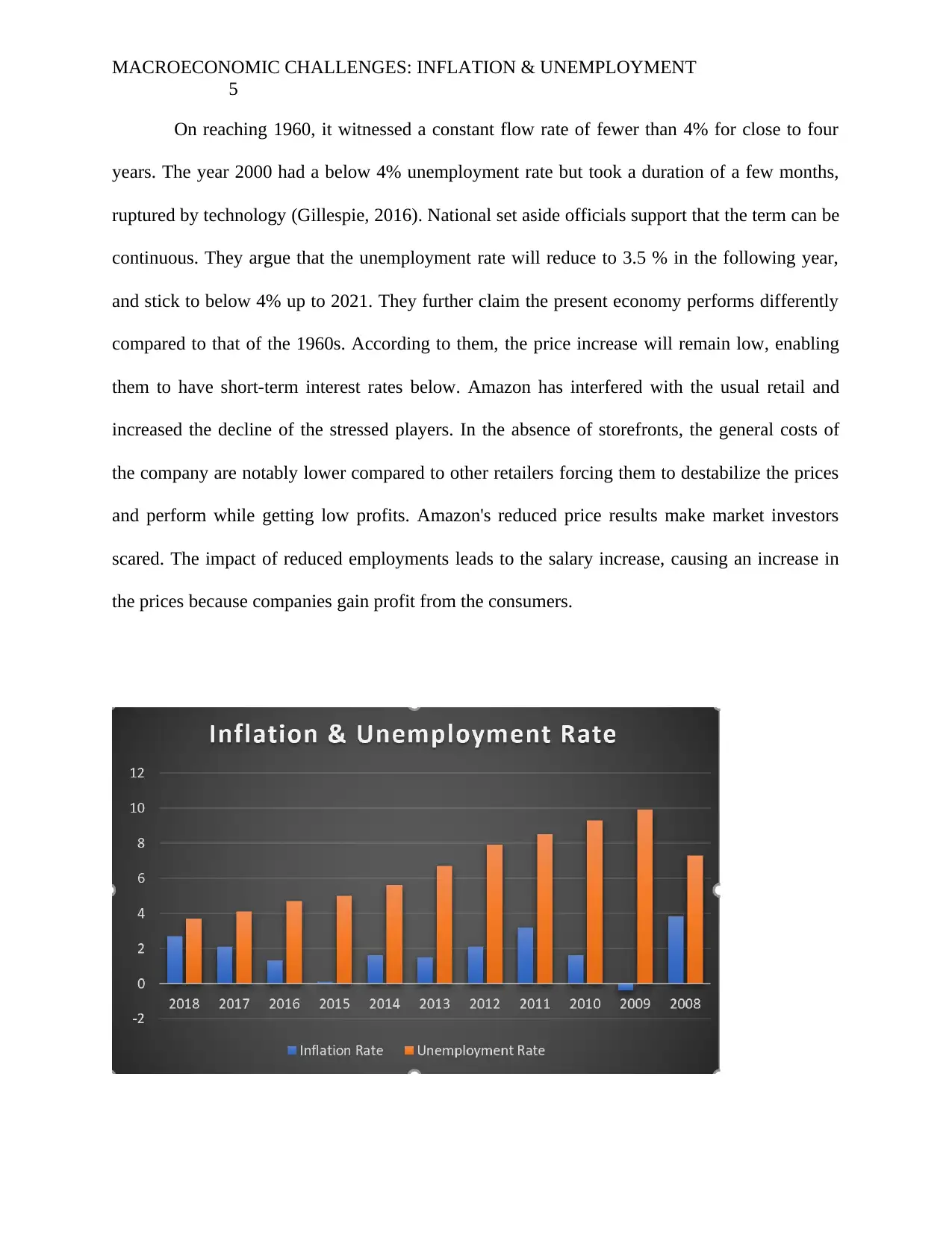
MACROECONOMIC CHALLENGES: INFLATION & UNEMPLOYMENT
5
On reaching 1960, it witnessed a constant flow rate of fewer than 4% for close to four
years. The year 2000 had a below 4% unemployment rate but took a duration of a few months,
ruptured by technology (Gillespie, 2016). National set aside officials support that the term can be
continuous. They argue that the unemployment rate will reduce to 3.5 % in the following year,
and stick to below 4% up to 2021. They further claim the present economy performs differently
compared to that of the 1960s. According to them, the price increase will remain low, enabling
them to have short-term interest rates below. Amazon has interfered with the usual retail and
increased the decline of the stressed players. In the absence of storefronts, the general costs of
the company are notably lower compared to other retailers forcing them to destabilize the prices
and perform while getting low profits. Amazon's reduced price results make market investors
scared. The impact of reduced employments leads to the salary increase, causing an increase in
the prices because companies gain profit from the consumers.
5
On reaching 1960, it witnessed a constant flow rate of fewer than 4% for close to four
years. The year 2000 had a below 4% unemployment rate but took a duration of a few months,
ruptured by technology (Gillespie, 2016). National set aside officials support that the term can be
continuous. They argue that the unemployment rate will reduce to 3.5 % in the following year,
and stick to below 4% up to 2021. They further claim the present economy performs differently
compared to that of the 1960s. According to them, the price increase will remain low, enabling
them to have short-term interest rates below. Amazon has interfered with the usual retail and
increased the decline of the stressed players. In the absence of storefronts, the general costs of
the company are notably lower compared to other retailers forcing them to destabilize the prices
and perform while getting low profits. Amazon's reduced price results make market investors
scared. The impact of reduced employments leads to the salary increase, causing an increase in
the prices because companies gain profit from the consumers.
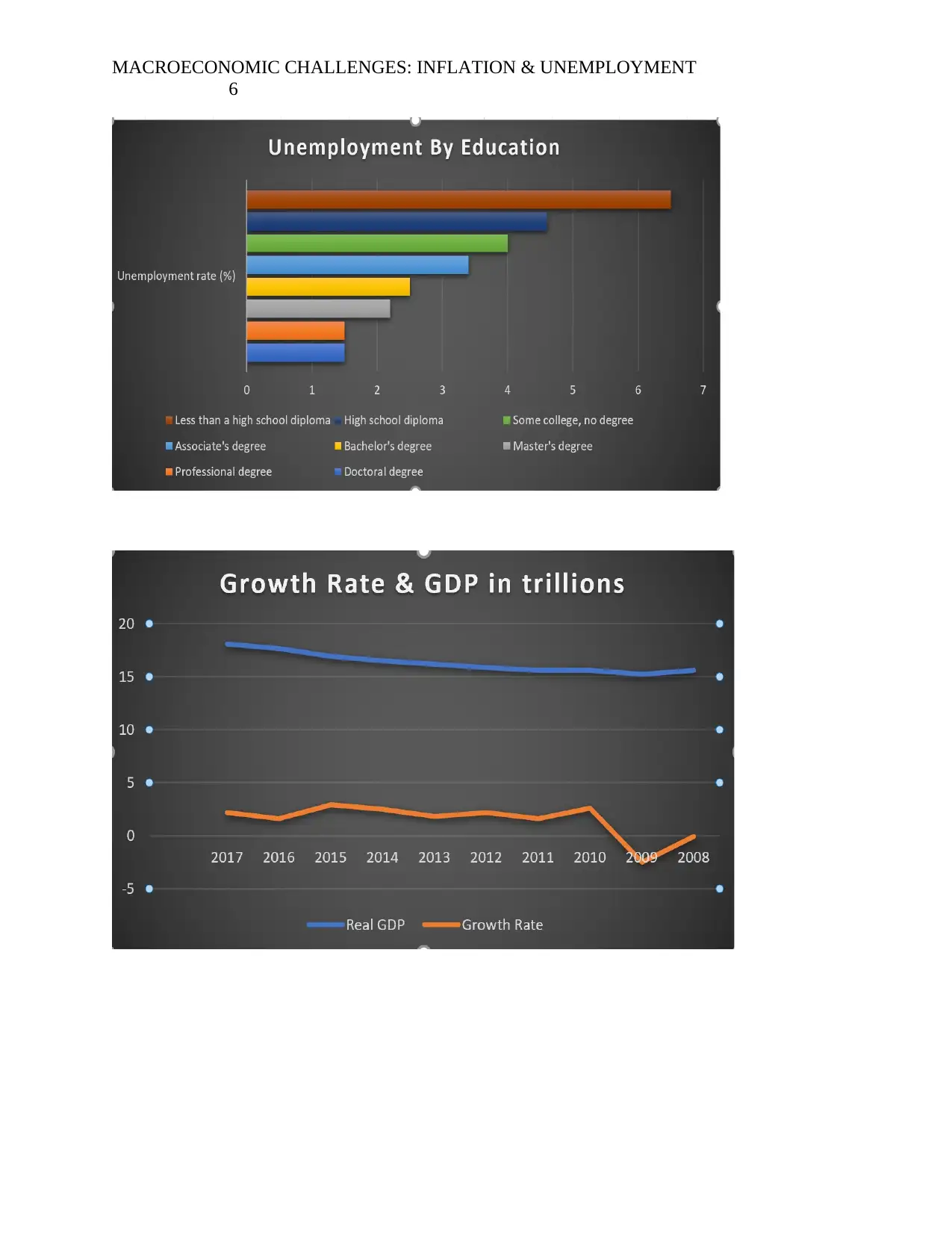
MACROECONOMIC CHALLENGES: INFLATION & UNEMPLOYMENT
6
6
⊘ This is a preview!⊘
Do you want full access?
Subscribe today to unlock all pages.

Trusted by 1+ million students worldwide
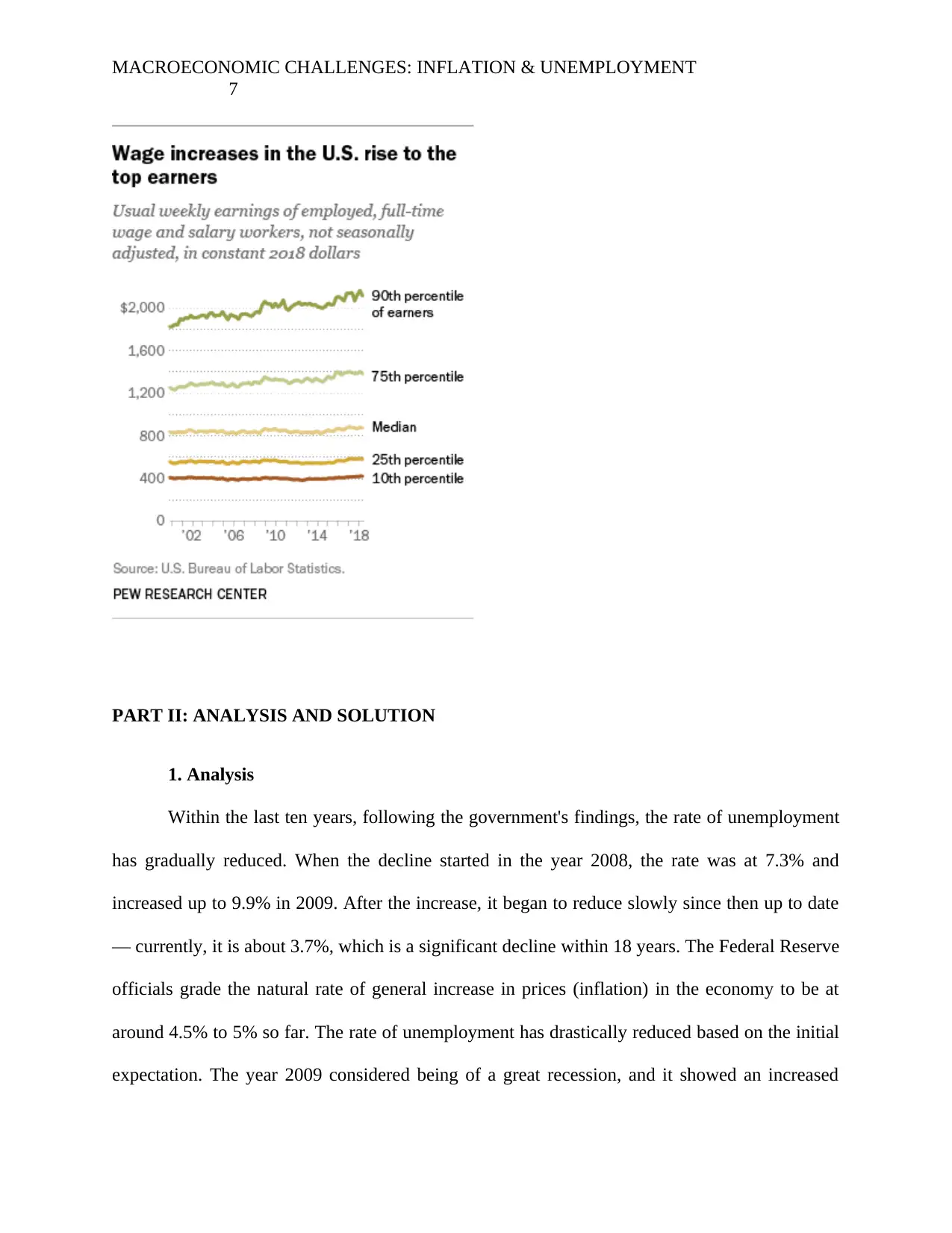
MACROECONOMIC CHALLENGES: INFLATION & UNEMPLOYMENT
7
PART II: ANALYSIS AND SOLUTION
1. Analysis
Within the last ten years, following the government's findings, the rate of unemployment
has gradually reduced. When the decline started in the year 2008, the rate was at 7.3% and
increased up to 9.9% in 2009. After the increase, it began to reduce slowly since then up to date
— currently, it is about 3.7%, which is a significant decline within 18 years. The Federal Reserve
officials grade the natural rate of general increase in prices (inflation) in the economy to be at
around 4.5% to 5% so far. The rate of unemployment has drastically reduced based on the initial
expectation. The year 2009 considered being of a great recession, and it showed an increased
7
PART II: ANALYSIS AND SOLUTION
1. Analysis
Within the last ten years, following the government's findings, the rate of unemployment
has gradually reduced. When the decline started in the year 2008, the rate was at 7.3% and
increased up to 9.9% in 2009. After the increase, it began to reduce slowly since then up to date
— currently, it is about 3.7%, which is a significant decline within 18 years. The Federal Reserve
officials grade the natural rate of general increase in prices (inflation) in the economy to be at
around 4.5% to 5% so far. The rate of unemployment has drastically reduced based on the initial
expectation. The year 2009 considered being of a great recession, and it showed an increased
Paraphrase This Document
Need a fresh take? Get an instant paraphrase of this document with our AI Paraphraser
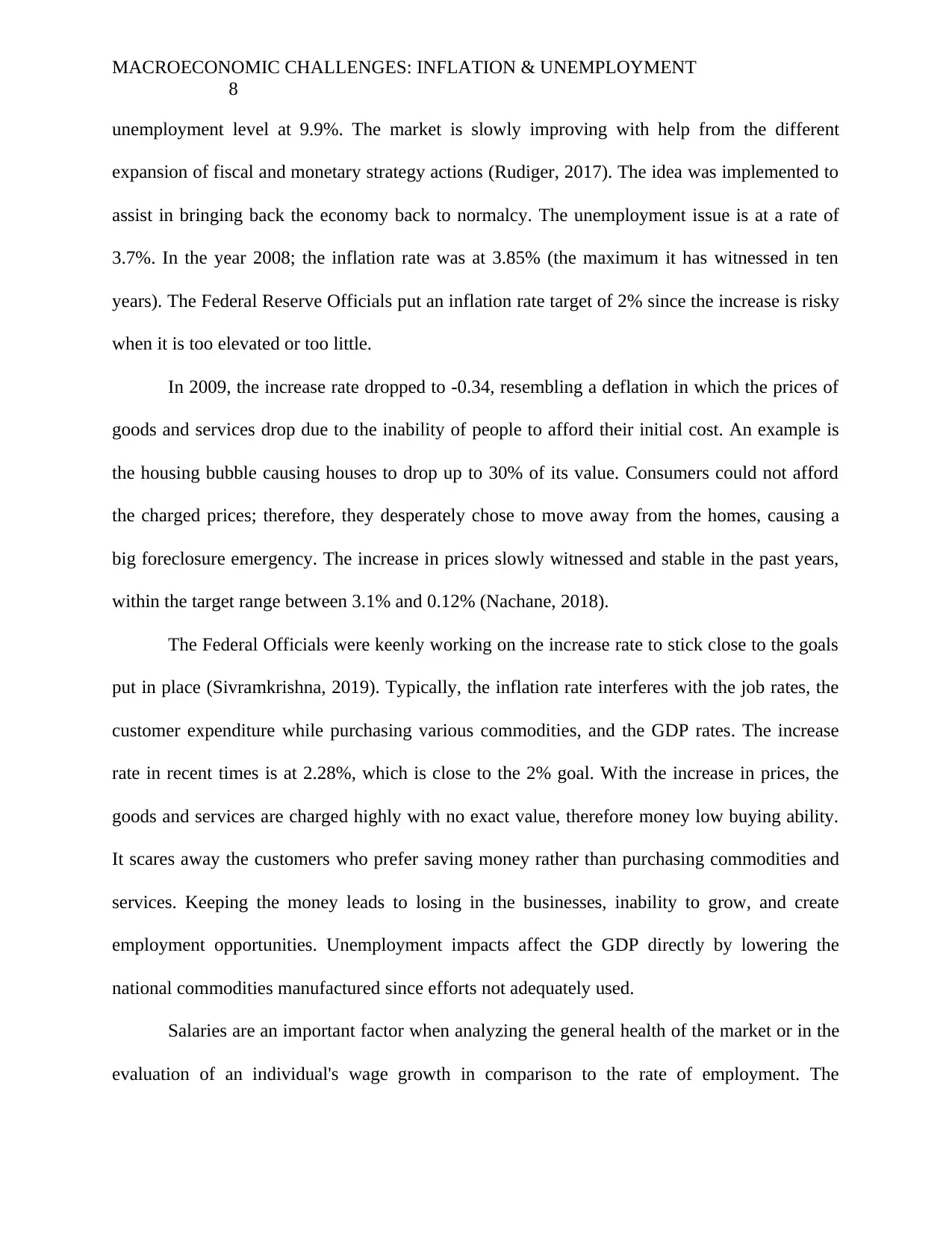
MACROECONOMIC CHALLENGES: INFLATION & UNEMPLOYMENT
8
unemployment level at 9.9%. The market is slowly improving with help from the different
expansion of fiscal and monetary strategy actions (Rudiger, 2017). The idea was implemented to
assist in bringing back the economy back to normalcy. The unemployment issue is at a rate of
3.7%. In the year 2008; the inflation rate was at 3.85% (the maximum it has witnessed in ten
years). The Federal Reserve Officials put an inflation rate target of 2% since the increase is risky
when it is too elevated or too little.
In 2009, the increase rate dropped to -0.34, resembling a deflation in which the prices of
goods and services drop due to the inability of people to afford their initial cost. An example is
the housing bubble causing houses to drop up to 30% of its value. Consumers could not afford
the charged prices; therefore, they desperately chose to move away from the homes, causing a
big foreclosure emergency. The increase in prices slowly witnessed and stable in the past years,
within the target range between 3.1% and 0.12% (Nachane, 2018).
The Federal Officials were keenly working on the increase rate to stick close to the goals
put in place (Sivramkrishna, 2019). Typically, the inflation rate interferes with the job rates, the
customer expenditure while purchasing various commodities, and the GDP rates. The increase
rate in recent times is at 2.28%, which is close to the 2% goal. With the increase in prices, the
goods and services are charged highly with no exact value, therefore money low buying ability.
It scares away the customers who prefer saving money rather than purchasing commodities and
services. Keeping the money leads to losing in the businesses, inability to grow, and create
employment opportunities. Unemployment impacts affect the GDP directly by lowering the
national commodities manufactured since efforts not adequately used.
Salaries are an important factor when analyzing the general health of the market or in the
evaluation of an individual's wage growth in comparison to the rate of employment. The
8
unemployment level at 9.9%. The market is slowly improving with help from the different
expansion of fiscal and monetary strategy actions (Rudiger, 2017). The idea was implemented to
assist in bringing back the economy back to normalcy. The unemployment issue is at a rate of
3.7%. In the year 2008; the inflation rate was at 3.85% (the maximum it has witnessed in ten
years). The Federal Reserve Officials put an inflation rate target of 2% since the increase is risky
when it is too elevated or too little.
In 2009, the increase rate dropped to -0.34, resembling a deflation in which the prices of
goods and services drop due to the inability of people to afford their initial cost. An example is
the housing bubble causing houses to drop up to 30% of its value. Consumers could not afford
the charged prices; therefore, they desperately chose to move away from the homes, causing a
big foreclosure emergency. The increase in prices slowly witnessed and stable in the past years,
within the target range between 3.1% and 0.12% (Nachane, 2018).
The Federal Officials were keenly working on the increase rate to stick close to the goals
put in place (Sivramkrishna, 2019). Typically, the inflation rate interferes with the job rates, the
customer expenditure while purchasing various commodities, and the GDP rates. The increase
rate in recent times is at 2.28%, which is close to the 2% goal. With the increase in prices, the
goods and services are charged highly with no exact value, therefore money low buying ability.
It scares away the customers who prefer saving money rather than purchasing commodities and
services. Keeping the money leads to losing in the businesses, inability to grow, and create
employment opportunities. Unemployment impacts affect the GDP directly by lowering the
national commodities manufactured since efforts not adequately used.
Salaries are an important factor when analyzing the general health of the market or in the
evaluation of an individual's wage growth in comparison to the rate of employment. The
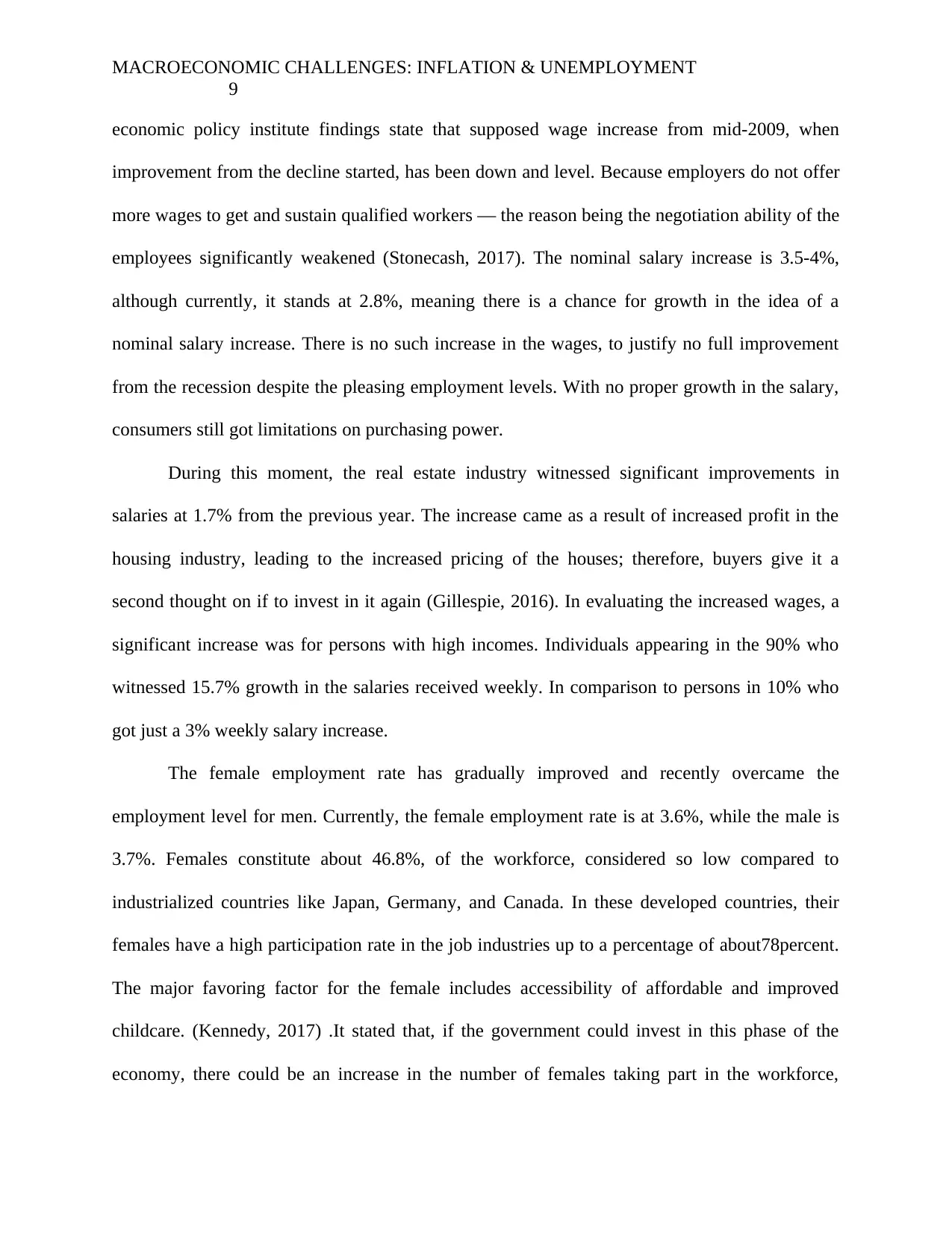
MACROECONOMIC CHALLENGES: INFLATION & UNEMPLOYMENT
9
economic policy institute findings state that supposed wage increase from mid-2009, when
improvement from the decline started, has been down and level. Because employers do not offer
more wages to get and sustain qualified workers — the reason being the negotiation ability of the
employees significantly weakened (Stonecash, 2017). The nominal salary increase is 3.5-4%,
although currently, it stands at 2.8%, meaning there is a chance for growth in the idea of a
nominal salary increase. There is no such increase in the wages, to justify no full improvement
from the recession despite the pleasing employment levels. With no proper growth in the salary,
consumers still got limitations on purchasing power.
During this moment, the real estate industry witnessed significant improvements in
salaries at 1.7% from the previous year. The increase came as a result of increased profit in the
housing industry, leading to the increased pricing of the houses; therefore, buyers give it a
second thought on if to invest in it again (Gillespie, 2016). In evaluating the increased wages, a
significant increase was for persons with high incomes. Individuals appearing in the 90% who
witnessed 15.7% growth in the salaries received weekly. In comparison to persons in 10% who
got just a 3% weekly salary increase.
The female employment rate has gradually improved and recently overcame the
employment level for men. Currently, the female employment rate is at 3.6%, while the male is
3.7%. Females constitute about 46.8%, of the workforce, considered so low compared to
industrialized countries like Japan, Germany, and Canada. In these developed countries, their
females have a high participation rate in the job industries up to a percentage of about78percent.
The major favoring factor for the female includes accessibility of affordable and improved
childcare. (Kennedy, 2017) .It stated that, if the government could invest in this phase of the
economy, there could be an increase in the number of females taking part in the workforce,
9
economic policy institute findings state that supposed wage increase from mid-2009, when
improvement from the decline started, has been down and level. Because employers do not offer
more wages to get and sustain qualified workers — the reason being the negotiation ability of the
employees significantly weakened (Stonecash, 2017). The nominal salary increase is 3.5-4%,
although currently, it stands at 2.8%, meaning there is a chance for growth in the idea of a
nominal salary increase. There is no such increase in the wages, to justify no full improvement
from the recession despite the pleasing employment levels. With no proper growth in the salary,
consumers still got limitations on purchasing power.
During this moment, the real estate industry witnessed significant improvements in
salaries at 1.7% from the previous year. The increase came as a result of increased profit in the
housing industry, leading to the increased pricing of the houses; therefore, buyers give it a
second thought on if to invest in it again (Gillespie, 2016). In evaluating the increased wages, a
significant increase was for persons with high incomes. Individuals appearing in the 90% who
witnessed 15.7% growth in the salaries received weekly. In comparison to persons in 10% who
got just a 3% weekly salary increase.
The female employment rate has gradually improved and recently overcame the
employment level for men. Currently, the female employment rate is at 3.6%, while the male is
3.7%. Females constitute about 46.8%, of the workforce, considered so low compared to
industrialized countries like Japan, Germany, and Canada. In these developed countries, their
females have a high participation rate in the job industries up to a percentage of about78percent.
The major favoring factor for the female includes accessibility of affordable and improved
childcare. (Kennedy, 2017) .It stated that, if the government could invest in this phase of the
economy, there could be an increase in the number of females taking part in the workforce,
⊘ This is a preview!⊘
Do you want full access?
Subscribe today to unlock all pages.

Trusted by 1+ million students worldwide
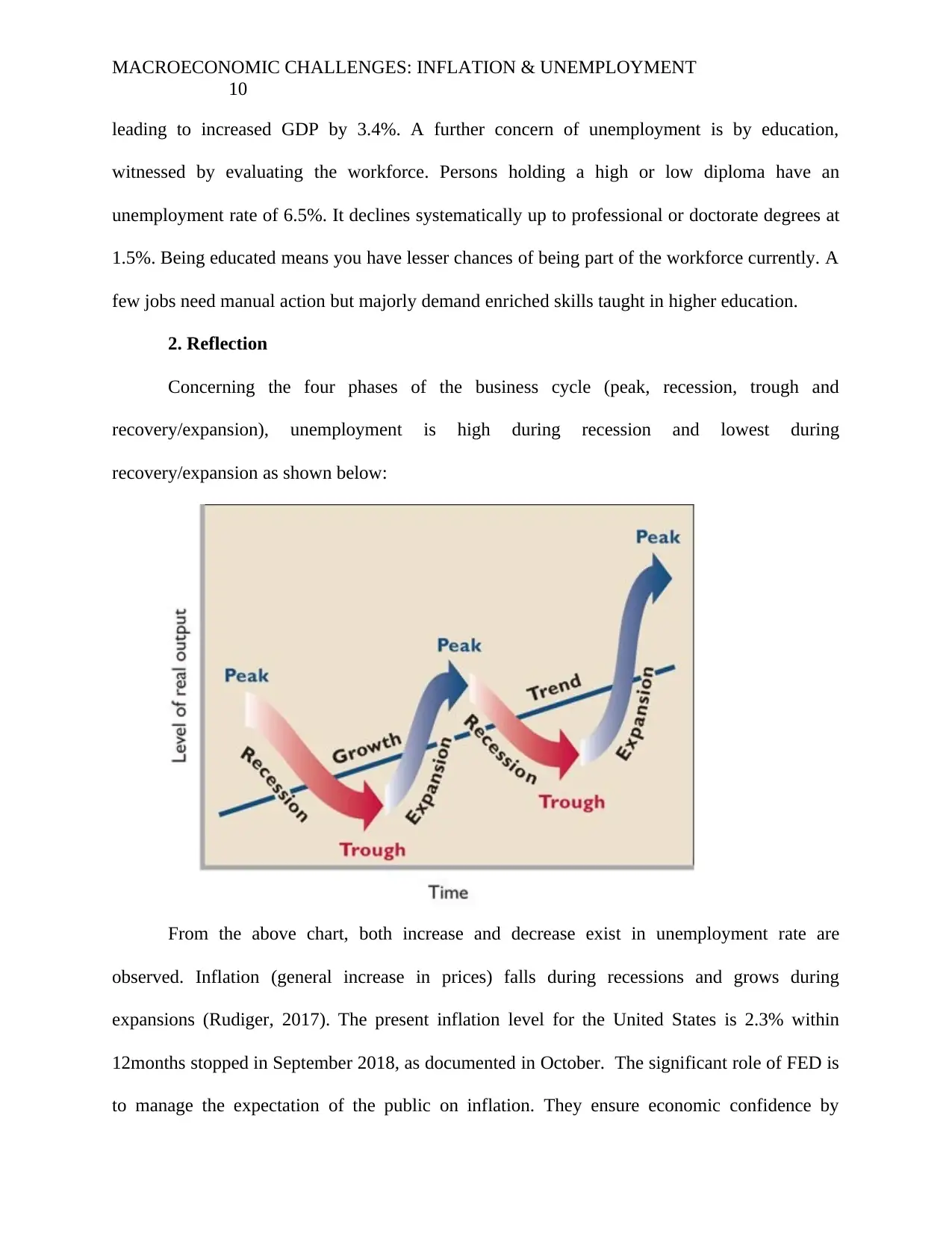
MACROECONOMIC CHALLENGES: INFLATION & UNEMPLOYMENT
10
leading to increased GDP by 3.4%. A further concern of unemployment is by education,
witnessed by evaluating the workforce. Persons holding a high or low diploma have an
unemployment rate of 6.5%. It declines systematically up to professional or doctorate degrees at
1.5%. Being educated means you have lesser chances of being part of the workforce currently. A
few jobs need manual action but majorly demand enriched skills taught in higher education.
2. Reflection
Concerning the four phases of the business cycle (peak, recession, trough and
recovery/expansion), unemployment is high during recession and lowest during
recovery/expansion as shown below:
From the above chart, both increase and decrease exist in unemployment rate are
observed. Inflation (general increase in prices) falls during recessions and grows during
expansions (Rudiger, 2017). The present inflation level for the United States is 2.3% within
12months stopped in September 2018, as documented in October. The significant role of FED is
to manage the expectation of the public on inflation. They ensure economic confidence by
10
leading to increased GDP by 3.4%. A further concern of unemployment is by education,
witnessed by evaluating the workforce. Persons holding a high or low diploma have an
unemployment rate of 6.5%. It declines systematically up to professional or doctorate degrees at
1.5%. Being educated means you have lesser chances of being part of the workforce currently. A
few jobs need manual action but majorly demand enriched skills taught in higher education.
2. Reflection
Concerning the four phases of the business cycle (peak, recession, trough and
recovery/expansion), unemployment is high during recession and lowest during
recovery/expansion as shown below:
From the above chart, both increase and decrease exist in unemployment rate are
observed. Inflation (general increase in prices) falls during recessions and grows during
expansions (Rudiger, 2017). The present inflation level for the United States is 2.3% within
12months stopped in September 2018, as documented in October. The significant role of FED is
to manage the expectation of the public on inflation. They ensure economic confidence by
Paraphrase This Document
Need a fresh take? Get an instant paraphrase of this document with our AI Paraphraser
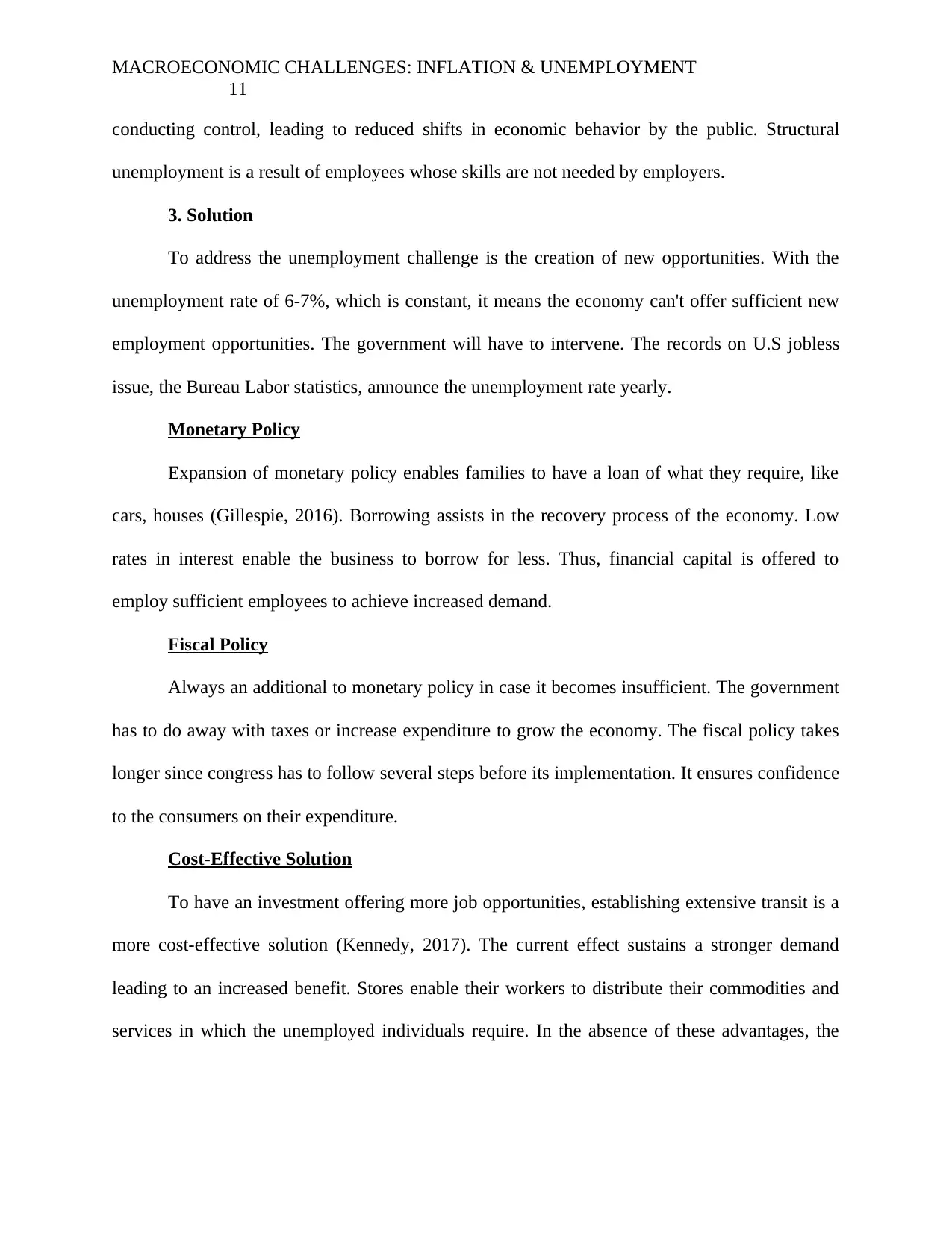
MACROECONOMIC CHALLENGES: INFLATION & UNEMPLOYMENT
11
conducting control, leading to reduced shifts in economic behavior by the public. Structural
unemployment is a result of employees whose skills are not needed by employers.
3. Solution
To address the unemployment challenge is the creation of new opportunities. With the
unemployment rate of 6-7%, which is constant, it means the economy can't offer sufficient new
employment opportunities. The government will have to intervene. The records on U.S jobless
issue, the Bureau Labor statistics, announce the unemployment rate yearly.
Monetary Policy
Expansion of monetary policy enables families to have a loan of what they require, like
cars, houses (Gillespie, 2016). Borrowing assists in the recovery process of the economy. Low
rates in interest enable the business to borrow for less. Thus, financial capital is offered to
employ sufficient employees to achieve increased demand.
Fiscal Policy
Always an additional to monetary policy in case it becomes insufficient. The government
has to do away with taxes or increase expenditure to grow the economy. The fiscal policy takes
longer since congress has to follow several steps before its implementation. It ensures confidence
to the consumers on their expenditure.
Cost-Effective Solution
To have an investment offering more job opportunities, establishing extensive transit is a
more cost-effective solution (Kennedy, 2017). The current effect sustains a stronger demand
leading to an increased benefit. Stores enable their workers to distribute their commodities and
services in which the unemployed individuals require. In the absence of these advantages, the
11
conducting control, leading to reduced shifts in economic behavior by the public. Structural
unemployment is a result of employees whose skills are not needed by employers.
3. Solution
To address the unemployment challenge is the creation of new opportunities. With the
unemployment rate of 6-7%, which is constant, it means the economy can't offer sufficient new
employment opportunities. The government will have to intervene. The records on U.S jobless
issue, the Bureau Labor statistics, announce the unemployment rate yearly.
Monetary Policy
Expansion of monetary policy enables families to have a loan of what they require, like
cars, houses (Gillespie, 2016). Borrowing assists in the recovery process of the economy. Low
rates in interest enable the business to borrow for less. Thus, financial capital is offered to
employ sufficient employees to achieve increased demand.
Fiscal Policy
Always an additional to monetary policy in case it becomes insufficient. The government
has to do away with taxes or increase expenditure to grow the economy. The fiscal policy takes
longer since congress has to follow several steps before its implementation. It ensures confidence
to the consumers on their expenditure.
Cost-Effective Solution
To have an investment offering more job opportunities, establishing extensive transit is a
more cost-effective solution (Kennedy, 2017). The current effect sustains a stronger demand
leading to an increased benefit. Stores enable their workers to distribute their commodities and
services in which the unemployed individuals require. In the absence of these advantages, the
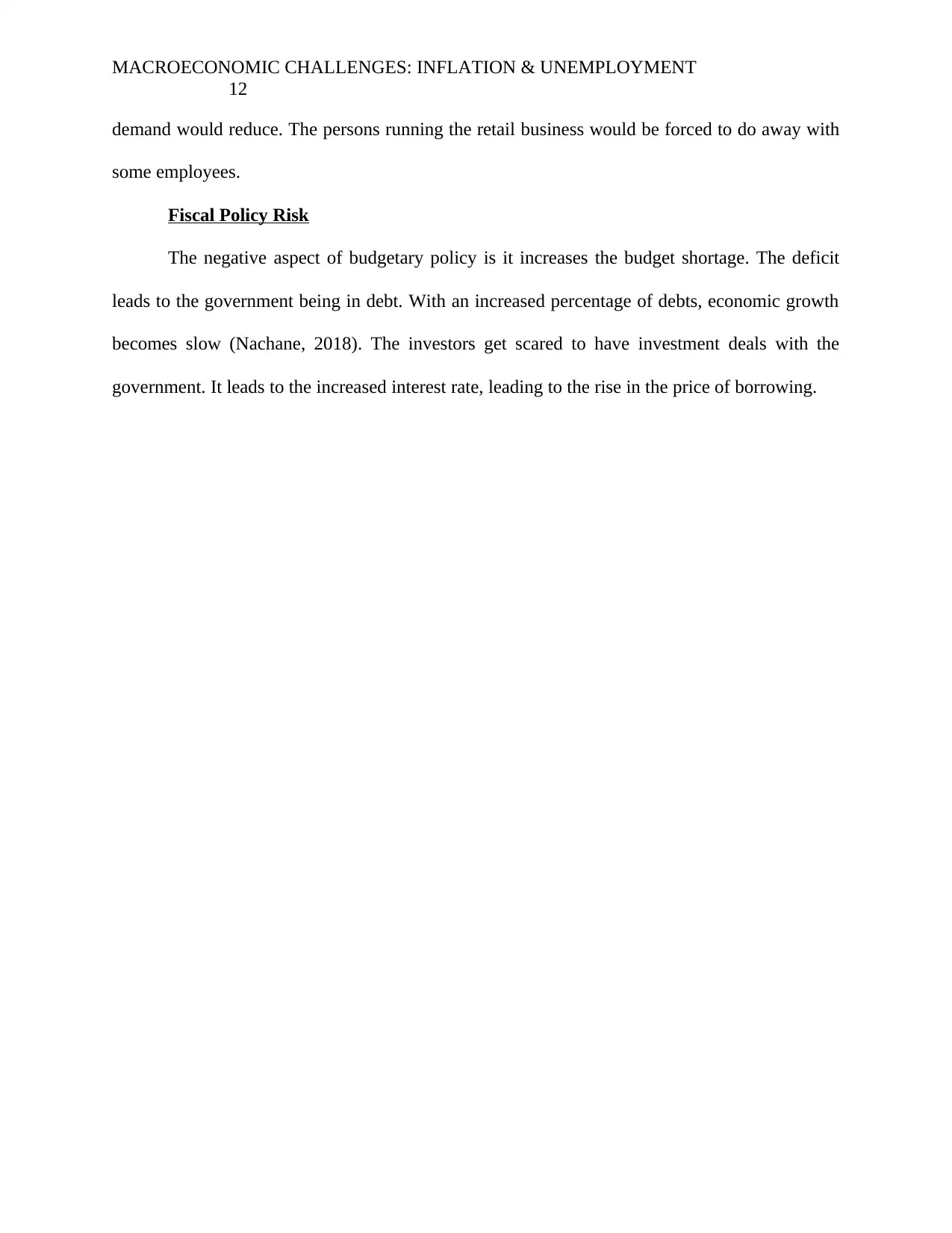
MACROECONOMIC CHALLENGES: INFLATION & UNEMPLOYMENT
12
demand would reduce. The persons running the retail business would be forced to do away with
some employees.
Fiscal Policy Risk
The negative aspect of budgetary policy is it increases the budget shortage. The deficit
leads to the government being in debt. With an increased percentage of debts, economic growth
becomes slow (Nachane, 2018). The investors get scared to have investment deals with the
government. It leads to the increased interest rate, leading to the rise in the price of borrowing.
12
demand would reduce. The persons running the retail business would be forced to do away with
some employees.
Fiscal Policy Risk
The negative aspect of budgetary policy is it increases the budget shortage. The deficit
leads to the government being in debt. With an increased percentage of debts, economic growth
becomes slow (Nachane, 2018). The investors get scared to have investment deals with the
government. It leads to the increased interest rate, leading to the rise in the price of borrowing.
⊘ This is a preview!⊘
Do you want full access?
Subscribe today to unlock all pages.

Trusted by 1+ million students worldwide
1 out of 13
Related Documents
Your All-in-One AI-Powered Toolkit for Academic Success.
+13062052269
info@desklib.com
Available 24*7 on WhatsApp / Email
![[object Object]](/_next/static/media/star-bottom.7253800d.svg)
Unlock your academic potential
Copyright © 2020–2025 A2Z Services. All Rights Reserved. Developed and managed by ZUCOL.





